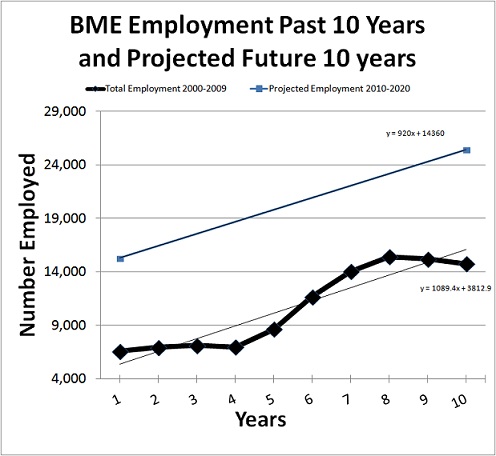Biomedical Engineering merges traditional engineering methods with biological sciences and medicine to enhance the quality of human health and life. Discipline focuses on understanding complex living systems - by means of experimental and analytical techniques and on development of devices, methods and algorithms which advance medical and biological knowledge though enhancing effectiveness and delivery of clinical medicine. Biomedical engineers may work in universities, hospitals, industry and laboratories. They take pleasure in the range of possible duties, as well as design and development of artificial organs, modelling of physical processes, development of blood sensors and other physiologic sensors, devise of beneficial strategies and machines for injury recovery, development and refinement of imaging methods and equipment, development of advanced detection systems, testing of product performance, and optimal lab design.
Biomedical engineers research and create medical technology like prosthetic limbs, pacemakers, implantable defibrillators and yet pharmaceuticals. They work directly with bioengineers, who relate biological and engineering notions to resolve problems in medicine and biology. Biomedical engineers aid enhance patient care and health outcomes –role which led their degree to be ranked fourth among top ten majors which change world, according to survey by PayScale, online salary database. Actually, almost 80 percent of biomedical engineering graduates feel their job is significant.
In the online biomedical engineering technology master’s degree program, students can get technical and scientific knowledge essential to create cutting-edge medical technology. Information on significant regulatory requirements is also included into program. Most online biomedical engineering technology master’s degree programs needs students have bachelor’s degree in engineering or related field.
Core course work comprises physiology, signal and system analysis, biomedical systems, engineering mathematics and molecular biology. Some programs give students opportunity to concentrate in the number of concentrations, biomaterials and tissue engineering; biomechanics and rehabilitation engineering; comprising computational engineering; and computational bioengineering and biomedical imaging.
Resolving Problems in exceptional Ways
While there are a number of individuals from conventional engineering majors who have obtained a background in biological sciences, there is vital requirement for engineers who have the skill to think in a way which integrates biology and engineering. These biology-based engineers, or bioengineers, must be able to solve problems in exclusive ways. As their knowledge of biology, they will be able to recognize new opportunities for application of engineering and for commercial development. As knowledge of engineering, they will bring inventive approaches to solving problems in biology and medicine.
Bioengineering is very broad discipline. In thinking about field, one could suppose matrix which along one side has all areas of biology and along other all fields of engineering. Applications which arise out of this matrix are virtually limitless. Bioengineering, though, is more than this matrix, for as we move into next century, there obviously is a requirement for true integration of biology and engineering, just as we before have integrated physics and chemistry into practice of engineering.
Biomedical Engineers specialize in variety of practical areas, biomechanics, comprising bioinstrumentation, biomaterials, clinical engineering, medical imaging, rehabilitation engineering and systems physiology
Bioinstrumentation comprises utilization of engineering principles and methods, comprising computers, in creating devices for diagnosis and treatment of disease. Biomechanics applies principles of mechanics to understand and reproduce medical problems and systems such as fluid transport and range of motion.
Biomaterials comprises development of natural living tissue and artificial materials for use in human body.
Clinical Engineering comprises development and maintenance of computer databases, inventorying medical equipment. Medical Imaging merges electronic data processing, analysis and show with understanding of physical phenomena to recognize and distinguish health problems like tumors, malformations and the like.
Rehabilitation Engineering concentrates on improving independence, capabilities and quality of life of individuals with physical impairments.

Job viewpoint
With projected employment growth of almost 62 percent by 2020, biomedical engineering is third fastest-growing occupation in nation, according to Bureau of Labour Statistics. Master’s degree in biomedical engineering technology can assist engineers changeover into field or advance their careers. Master’s degree is classically needed for professionals to lead the research team, according to BLS.
Biomedical engineers discover employment in the variety of industries, as well as hospitals, manufacturing, universities, government regulatory agencies and research facilities. Majority of biomedical engineers work in medical equipment and provides manufacturing, and scientific research and development services. Median salary of biomedical engineers is nearly $82,000, but top 10 percent earn more than $127,000 annually, according to BLS.